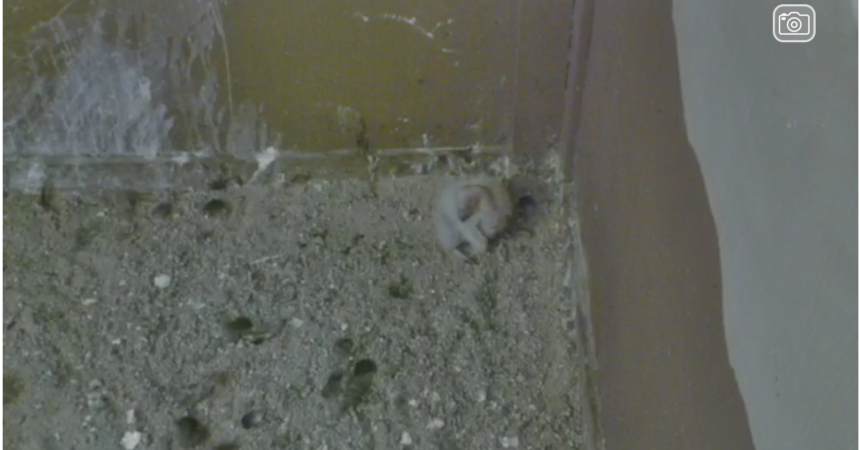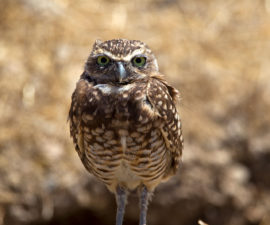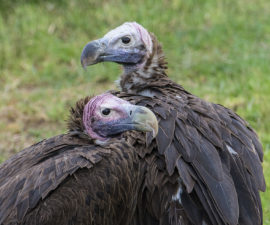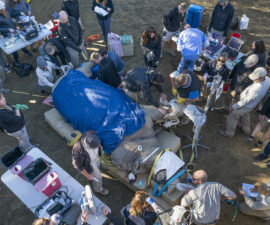Our California condor chick on Condor Cam has a name: Luhui (pronounced “loo-HOO-ee”). It is a Chumash word, meaning “native.”
At approximately two to three weeks of age, the real fun of condor chick viewing begins! The chick is getting bigger, weighing between 17.6 and 42 ounces (500 and 1,200 grams), and can often be seen poking its head out from under the parents’ wings. The parents might be spending less time sitting on the chick, weather permitting, leaving it unattended for longer periods of time—possibly 30 minutes or so. Never fear—the parents are nearby, often just out of the camera’s view, approximately six to eight feet away.
It is usually easier to observe feeding behavior at this age, as well. The parents stand a little to the side of the chick now, so you may catch a glimpse of food actually being transferred from the parent to the little one. The chick’s crop may be visible when it’s full (the crop is a bulge in the esophagus where food is stored). It is between the size of a golf ball and a tennis ball, and looks like a bald patch of skin. You will also witness a very common behavior called “wing-begging.” This is when the chick is begging for food, flapping one or both of its stubby little wings and bobbing its head excitedly. This behavior can persist until after the chick fledges, or leaves its nest, at four to five months old. As you’re watching our pride and joy, you may see some things that spark questions or concern—know that we are also watching/monitoring! Some of the things cam viewers observe have natural and interesting explanations. For example…
Luhui hatched wearing a fluffy coat of white down feathers. The main function of down is insulation; it can either keep a bird cool or warm, whatever its body needs. At this stage, the chick’s white down is starting to transition to gray. Sometimes this can make the chick look dirty or scruffy, but it is still as healthy as it ever has been. It and the parents are frequently grooming the feathers to make sure they are working the way they should be. These dark feathers also help the chick blend in with the substrate and the nest cave walls, since the parents are not covering the chick as much as they recently were.
Sometimes, the chick looks like it has scabs on its head/neck or has wounds on its body, matting its down feathers. This is actually regurgitated food stuck to its face or body. Feeding can be quite exciting for the chick, and some food doesn’t always end up in its mouth! The chick obviously can’t take a bath at this age, but the food will dry up, get crusty, and flake off—a major benefit of having a bald head! Anyone who has seen the big condors eat on exhibit at Condor Ridge at the San Diego Zoo Safari Park or Elephant Odyssey at the San Diego Zoo can attest to the condors’ ability to keep clean after a messy meal. Also, the presence of flies in the nest is nothing to worry about. Keep in mind that condors are carnivores, feed their chicks via regurgitation, and nest in cavities (caves, crevices, etc.) that are often sheltered from the wind. All of these components add up to a very comfortable environment for flies as well as condors. Happily, condors have an excellent immune system and are only mildly annoyed by the flies.
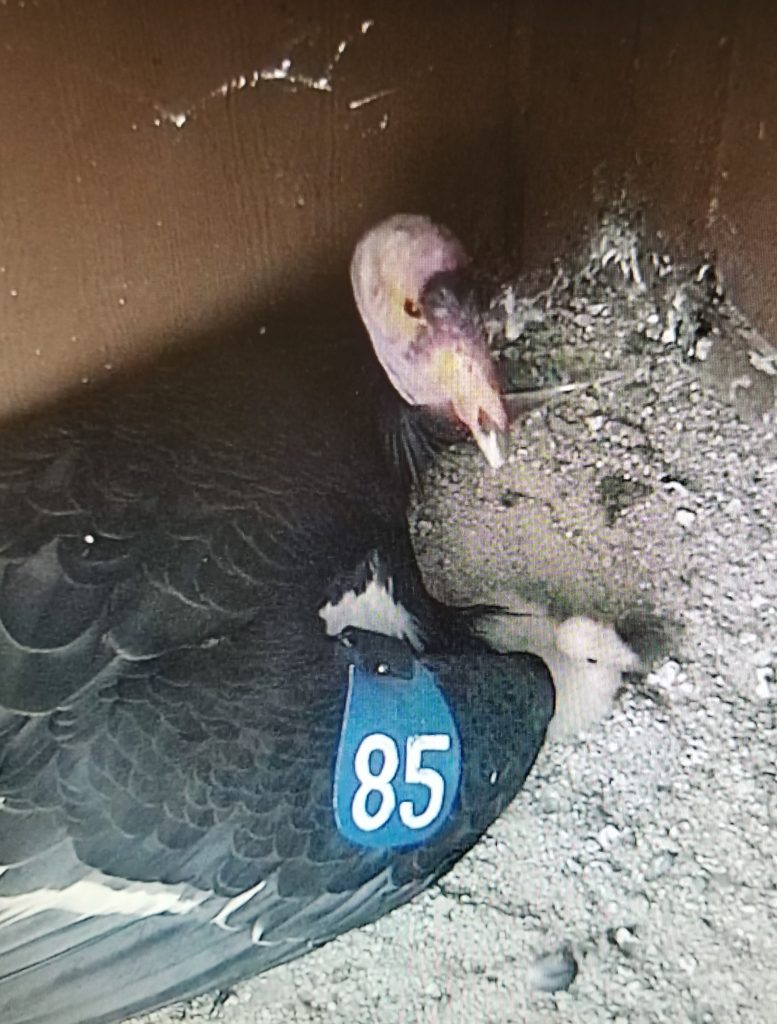
At three weeks of age, weighing 2 pounds, 10 ounces to 3 pounds, 4 ounces (1.2 to 1.5 kilograms), condor chicks can start to thermoregulate, or control their own body temperature. This is when the parents can start leaving the chicks on their own during the day. Depending on the ambient temperature, the chick may be seen shivering or panting in an effort to warm or cool itself. Also, on warm days, the chick may inflate the air sacs in its chin and neck to cool down. Air sac inflation can also occur after a particularly filling meal.
Also at this time, the chick is more mobile, scooting around the nest on its haunches, or tarsal joints. We refer to this as a “tarsal crawl.” It’s not quite standing up on its feet, but it can move about, following the parents and investigating different parts of the nest. You may see Luhui start to gather items (feathers, scraps of old food, etc.) from around the nest and move them to one corner. The chick likes to sit or sleep on this pile and play with the different items. These feathers and old food scraps are often brought to the nest by the parents. Birds replace their feathers through a process called “molting,” similar to when mammals shed their hair/fur. We don’t know if the parents are deliberately bringing these items to the nest specifically for the chick or if it’s just coincidence, but the chick loves to investigate and play with them!
As Siwon and Sola start leaving Luhui alone for longer periods of time, it will be easier to watch the chick when it sleeps. Just like all growing youngsters, condor chicks sleep A LOT. With longer legs and gawky bodies, it often will be sprawled out, wings askew, in odd positions when it sleeps. Do not worry! The chick is perfectly fine.
At approximately 1 month of age, the chick weighs around 4 pounds (1.8 kilograms). The parents may start leaving the chick alone overnight, sleeping outside near the nest. If the weather is still cool or it’s raining, the parents may continue to brood overnight until the weather improves. Even though the parents are increasing their time away from the chick, they remain VERY vigilant and protective of their nest and–especially—their chick.
Happy viewing, and thanks so much for your support!
Ron Webb is a senior keeper at the San Diego Zoo Safari Park. Read his previous blog, California Condor Chick-Watching: Hatch to One Week of Age

